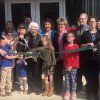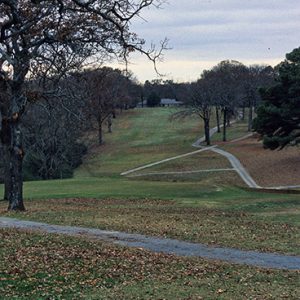calsfoundation@cals.org
Sherwood (Pulaski County)
| Latitude and Longitude: | 34º48’54″N 092º13’28″W |
| Elevation: | 328 feet |
| Area: | 20.74 square miles (2020 Census) |
| Population: | 32,731 (2020 Census) |
| Incorporation Date: | April 22, 1948 |
Historical Population as per the U.S. Census:
|
1810 |
1820 |
1830 |
1840 |
1850 |
1860 |
1870 |
1880 |
1890 |
1900 |
|
– |
– |
– |
– |
– |
– |
– |
– |
– |
– |
|
1910 |
1920 |
1930 |
1940 |
1950 |
1960 |
1970 |
1980 |
1990 |
2000 |
|
– |
– |
– |
– |
717 |
1,222 |
2,754 |
10,423 |
18,893 |
21,511 |
|
2010 |
2020 | ||||||||
|
29,523 |
32,731 |
Sherwood is a city in Pulaski County central Arkansas just north of North Little Rock (Pulaski County). In 1990, Sherwood was named the fastest-growing town in Arkansas, in terms of both population and area, as it has annexed land many times over the years.
Sherwood began in the late 1800s as a small farming community known as Sylvan Hills. Few families lived there until the early 1900s. For many years, they had no running water, electricity, or utilities. Another part of modern Sherwood is the lowland area known as Brushy Island, where both white and African American farmers lived; this area was the site of a series of events called the “Brushy Island Riots” in the late 1910s. Around 1923, the first running water was carried through pipes from three springs on a farm belonging to the Koehler family. Many descendants of their family still live on Koehler Lane in Sherwood. The oldest standing home in the original city limits of Sherwood is probably the house at 829 Koehler Lane, which was built for Paul Koehler in 1927.
On April 22, 1948, Sherwood was officially incorporated as a town. Mayor Hal P. Lacoste and the first town council were elected on July 10. A special census held that September found a population of 714 people—352 males and 362 females. There were 194 dwelling units. The first town hall was a 16′ x 16′ army surplus building, which was purchased for less than $100. To pay for it, the Home Demonstration Clubs sponsored a Miss Sherwood contest. The town hall building was on the corner of Sherwood and Delmont avenues, which was once called Triangle Park and is now Delmont Park.
In 1948, the Little Rock (Pulaski County) Young Men’s Christian Association (YMCA) gave Sherwood a building to use for community activities, such as a club for teenagers. Several organizations, including the Church of Christ, met there. Residents of Sherwood put the building on concrete blocks and attached a 16′ x 16′ building as a kitchen.
In 1950, there was a campaign to have Sherwood give up its status as a town. Mrs. George Mertens, the editor of the Sherwood News, wrote, “Let’s face it—there are people living in Sherwood who would like us to give up our charter of incorporation. Why? Because there are people all over who resent having to abide by any kind of law.” Many people worked hard to convince the Sherwood residents to remain an official town, and they succeeded in 1951. On September 6, 1950, a volunteer fire department was organized, but it was not until September 1951 that the town was able to get its own fire truck.
The town newspaper, the Sherwood News, was put together by volunteers from 1950 to 1970. In 1964, two women began a grocery flyer that later became the Voice newspaper. In 1972, when it became the official town newspaper, it published two issues a week.
Until 1966, when Sherwood’s first post office was established, mail had to go through North Little Rock’s postal services. Sherwood got a separate zip code from North Little Rock in the 1990s.
In April 1998, Sherwood celebrated its fiftieth anniversary with a breakfast, which residents called the Ole Timers Breakfast, and parade. A time capsule buried in 1976 was opened, and items were added to it before its reinterment in May at the city compound, with plans for it to be reopened at Sherwood’s seventy-fifth anniversary in 2023. Unfortunately, the time capsule was not sealed properly, and its contents were discovered to have been destroyed upon being opened in 2023.
In February 2008, Jacksonville (Pulaski County) voted to annex Gravel Ridge (Pulaski County), a small community between Sherwood and Jacksonville. Sherwood also voted to annex Gravel Ridge, and so the people living in Gravel Ridge had to vote on which they wanted to join. On April 1, 2008, they had the final election, and the results were for Sherwood, 632 to 221.
On March 31, 2023, the city was hit by a tornado leaving half of Sherwood without power.
Education
Plans for the first elementary school began in 1959, since there were 388 children under the age of twelve living in Sherwood. The town raised money with a Miss Sherwood Elementary School contest. The school was supposed to open on September 6, 1960, but a sewer problem delayed the opening. The Sylvan Hills Junior High graduated its first class in 1954, and the North Hills Exceptional School, which began on October 31, 1955, with five children, had tripled its enrollment by the end of the first year. It is now the North Hills Services for the Handicapped.
Sherwood has several public schools and magnet schools; the public schools are part of the Pulaski County Special School District. The William Jefferson Clinton School, opened in Sherwood in 1995, was the first school in the country named after President Clinton. Although the schools in Sherwood were segregated in the town’s early years, desegregation was not a major issue. White students now have only a slight majority in the schools, even though the population of Sherwood is seventy-five percent white, as of the 2010 census.
Industry
The first official business in Sherwood was the Sherwood Grocery, which opened in 1947 but closed in 1992. In 1967, Sherwood’s first bank opened. It was called First Bank of Sherwood until 1988, when it changed its name to Eagle Bank and Trust Company. The leading industries in Sherwood are education, health and social services, and retail trade. As of 2008, only about sixteen percent of the people who live in Sherwood also work there.
Attractions
Sherwood hosts the Sherwood Sports Complex. The Henson Park Tennis Center has four tennis courts and a pro shop. The Bill Harmon Recreation Center, which opened in April 2002, has an indoor basketball court, meeting rooms, fitness equipment, an indoor pool, and a game room.
Sherwood has seventeen parks and four public swimming pools. Sherwood Forest is a 26,000-square-foot complex that is used for meetings, private parties, and events. The Kevin McReynolds Sports Complex, named after a major league baseball player who attended Sylvan Hills High School, is a 180-acre park featuring seven baseball fields, five softball fields, a soccer field, three concession stands, playgrounds, pavilions, and covered bleachers. The Sherwood Fest held every fall features a pancake breakfast, crafts and food for sale, and rides and entertainment for children and adults. An annual Halloween Festival is held for children. The Sherwood Christmas Parade was first held in 1973 and is sponsored by the Sherwood Chamber of Commerce.
One historic structure in Sherwood is the Roundtop Filling Station on Trammel Road, built in 1936 by Justin Matthews for the Pierce Oil Company. For many years, it was the only modern restroom stop between Searcy (White County) and Little Rock. When Trammel Road was annexed to Sherwood in 1975, the Roundtop station came with it. The structure was renovated, and, despite an arson attempt, found a new use as a substation for the Sherwood Police Department. The Greens at North Hills, a country club and golf course built in 1926, is listed on the National Register of Historic Places. Sherwood is also home to the KOKY radio station.
Olympic winner Jeff Henderson participated in track and field while he attended high school in Sherwood at Sylvan Hills High. Professional golfer Dawn Darter was born and grew up in Sherwood and returned there later in life to serve as the club pro for the Greens at North Hills.
For additional information:
Duran, Ailene. The Signs Say Sherwood. Sherwood, AR: Heritage Press, 1976.
Duran, Ron, Cheryl Ferguson, Marvelle Harmon, Sarah Henson, Amy Sanders, and Becki Vasser. The Signs Still Say Sherwood: The Next 25 Years. Sherwood, AR: Arrow Printing, 2002.
Sandlin, Jake. “Old Sherwood Home Intrigues Researchers.” Arkansas Democrat-Gazette, July 24, 2016. https://www.arkansasonline.com/news/2016/jul/24/old-sherwood-home-intrigues-researchers-1/ (accessed January 10, 2024).
Sherwood, Arkansas. http://www.cityofsherwood.net/ (accessed September 14, 2022).
Anastasia Teske
North Little Rock, Arkansas
 Sanders, Amy
Sanders, Amy Greens at North Hills
Greens at North Hills  Bill Harmon
Bill Harmon  Henson Park Entrance
Henson Park Entrance  Lou Holtz in Sherwood
Lou Holtz in Sherwood  Jackie Hudson at Sherwood Grocery
Jackie Hudson at Sherwood Grocery  Bob LaCoste
Bob LaCoste  Pulaski County Map
Pulaski County Map  Amy Sanders
Amy Sanders  Sherwood Fest
Sherwood Fest  Sherwood City Flag
Sherwood City Flag  Sherwood Fest
Sherwood Fest  Sylvan Hills Country Club
Sylvan Hills Country Club  Buddy Villines and Bill Harmon
Buddy Villines and Bill Harmon 



Within our current city, having annexed Sylvan Hills, Brush Island (east), and Gravel Ridge, the oldest house is at 2308 E. Kiehl Ave., on the church property of First Christian Church. It was first built in the early 1890s by Robert Clayton, whose son Lonnie bought the 200-acre farm from his winnings as a horse jockey. Clayton Chapel Bapist (1895) was also named for Robert Clayton, as he helped build it. The white farm house eventually became a boarding house. Tenants used to farm the Vandenbergs’ property as well being hired hands for the Lea family, who were friends of the Vandenbergs. The house became property of First Christian Church in 1961. Education: The first schools built in what is now Sylvan Hills for elementary and middle school children were off Hwy 107 in 1920. Today, they are a Nazarene Church and Retirement Center. Near the Indian Head subdivision, formerly Brush Island east, an African-American school was rebuilt, the Morning Grove School, with help from the Rosenwald Fund in 1922. These items predate the establishment of Sherwood, but are on land now occupied by the city.